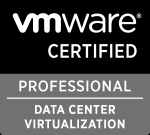VMware has launched a new certification exam VCP550 which allows to take the exam based on vSphere 5.5. There is no new certification, you will still earn the VCP5-DCV certification as if you have passed the VCP510 exam based on vSphere 5.0/5.1. If you already own the VCP5-DCV there is no reason to take the exam.
The main topics of the new exam are 5.1 and 5.5 features like vSphere Data Protection (VDP), vCenter Operations Manager (vCOPS), vSphere Flash Read Cache (vFlash), Single Sign-on and the vSphere Webclient.
Detailed changes
Objective 1.2 - Install and Configure vCenter Server
• Create a database connection to the vCenter Server database
• Identify Single Sign-On requirements
• Identify vCenter Server and vCenter Server database requirements
• Install and Configure the vSphere Client / vSphere Web Client
Objective 1.3 – Install and Configure VMware ESXi
• Identify ESXi host requirements
• Select a CPU power management policy
Objective 1.4 – Plan and Perform Upgrades of vCenter Server and VMware ESXi
• Stage multiple ESXi Host upgrades
Objective 1.5 – Secure vCenter Server and ESXi
• Configure and administer Single Sign-On
• Describe Single Sign-On architecture
• Differentiate Single-Sign-On Deployment Scenarios
• Direct Console User Interface (DCUI)
• Manage Single Sign-On users and groups
Objective 2.2 – Configure vSphere Distributed Switches
• Backup/Restore vDS configuration
• Configure LACP on Uplink portgroups
• Configure vSphere Distributed Switch general and dvPort group settings
• Monitor dvPort state
Objective 2.3 – Configure vSS and vDS Policies
• Configure VLAN/PVLAN settings
• Describe vDS Security Polices/Settings
Objective 3.1 – Configure Shared Storage for vSphere
• Configure FC/iSCSI LUNs as ESXi boot devices
Objective 4.3 – Manage Virtual Machine Clones and Templates
• Create a Local/Remote Content Library with/without external storage (VMs, ISOs, Scripts, vApps)
• Identify content types
• Publish/Subscribe/Share a Content Library
Objective 4.4 – Administer Virtual Machines and vApps
• Configure Serial port redirection
• Configure USB passthrough from an ESXi Host
Objective 5.1 – Create and Configure VMware Clusters
• Determine appropriate power threshold for a given implementation
• Enable BIOS P/C states
• Enable/Configure/Disable Host Power Management/Distributed Power Management
Objective 5.3 – Create and Administer Resource Pools
• Describe vFlash architecture
• Assign vFlash resources to VMDKs
• Create/Delete vFlash Resource Pool
Objective 5.5 – Backup and Restore Virtual Machines
• Identify snapshot requirements
• Identify VMware Data Protection requirements
• Configure Replication for Single/Multiple VMs
• Differentiate between VDP and VDPA
• Create a backup job with VMware Date Protection
• Create/Delete/Consolidate virtual machine snapshots
• Describe vSphere Replication architecture
• Determine appropriate backup solution for a given vSphere implementation
• Explain VMware Data Protection sizing guidelines
• Install and Configure VMware Data Protection
• Install/Configure/Upgrade vSphere Replication
• Manage and monitor VDP capacity
• Perform a failback operation using vSphere Replication
• Perform a test/live full/file-level restore with VMware Data Protection
• Perform a VDR data migration
• Recover a VM using vSphere Replication
Objective 5.6 – Patch and Update ESXi and Virtual Machines
• Import/Export a Host Profile
Objective 7.3 – Install, Configure and Administer vCenter Operations Manager
• Deploy and Configure vCOPs appliance
• Differentiate Major/Minor vCOPs badges
• Explain vCOPs architecture
• Monitor vSphere environment
• Understand metrics used by Major/Minor vCOPs badges
• Upgrade vCOPs
Source
vSphere 5.0/5.1 Based Exam Blueprint (VCP510)
vSphere 5.5 Based Exam Blueprint (VCP550)

Pingback: Neue VMware VCP5-DCV Zertifizierung VCP550 | all of my brain